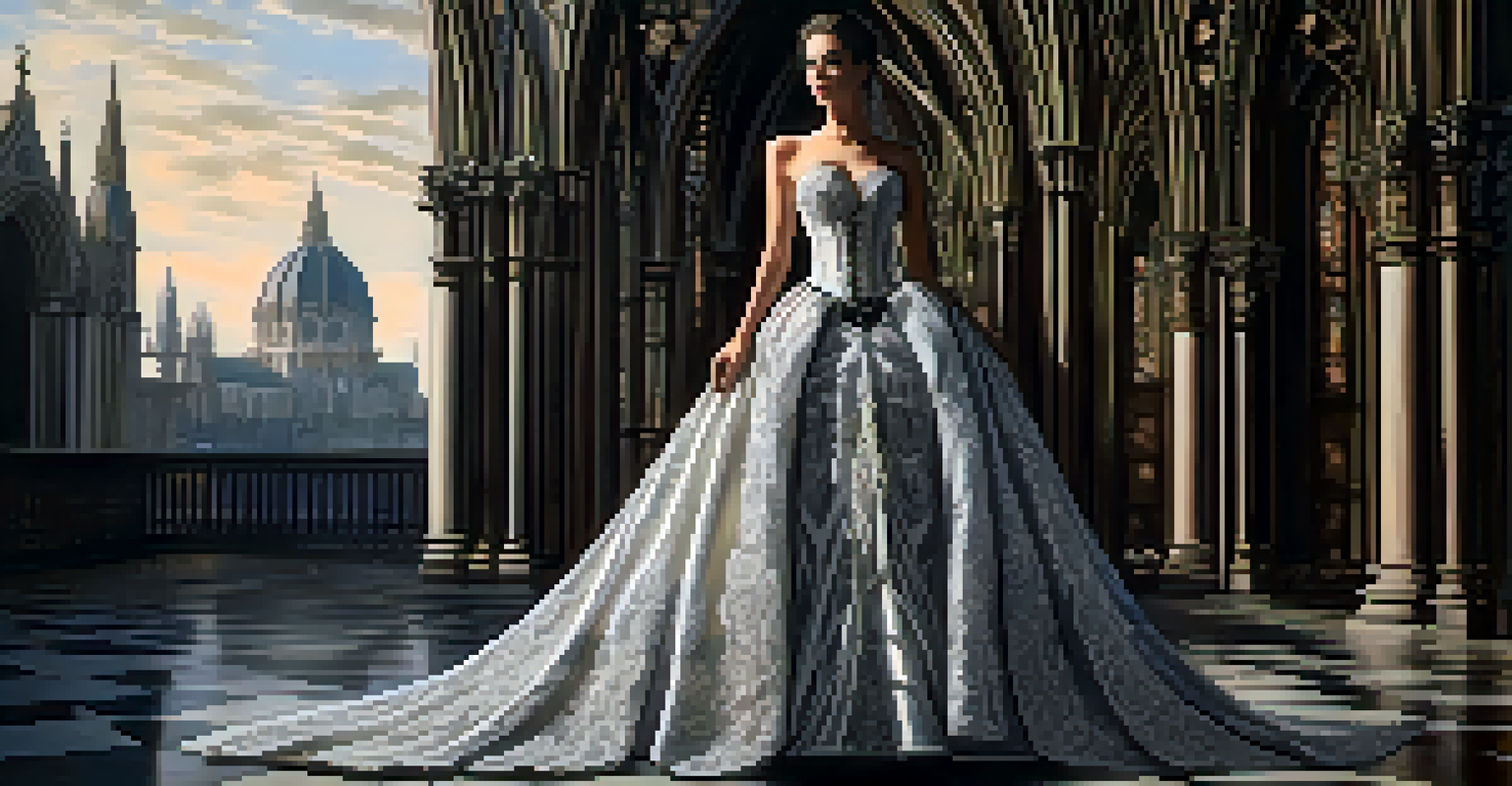Historical Perspectives: Fashion Inspired by Architectural Eras

The Influence of Ancient Egypt on Modern Fashion
Ancient Egypt is renowned for its iconic architecture, such as the pyramids and temples, which showcase symmetry and grandeur. These architectural features have inspired modern fashion through the use of structured silhouettes and luxurious fabrics. For instance, the draped linen garments of the Egyptians can be seen echoed in contemporary designs that favor flowing lines and elegant draping.
Fashion is the armor to survive the reality of everyday life.
Furthermore, the rich color palette found in Egyptian art and architecture, including golds, deep blues, and warm earth tones, often reappears in today’s fashion lines. Designers frequently draw from these hues to create collections that evoke a sense of opulence and history. This connection between color and form highlights how architectural aesthetics can translate into wearable art.
Moreover, the influence extends beyond just colors and shapes; it also touches on motifs and symbols. Egyptian hieroglyphs and patterns inspire textile designs, making the connection between architecture and fashion not just visual but also cultural. This interplay fosters an appreciation for heritage and tradition, inspiring modern designers to celebrate historical influences.
Classical Architecture and the Birth of Tailoring
The grandeur of Classical architecture, especially from Ancient Greece and Rome, laid the groundwork for tailored fashion. The ideals of proportion and harmony found in classical columns and facades influenced the structured garments of the period, such as togas and tunics. These clothing styles emphasized the natural form of the body, much like how classical structures showcased symmetry and balance.

As tailoring evolved through the ages, the influence of architectural principles remained evident. The meticulous craftsmanship seen in classical buildings parallels the precision required in tailored garments, where fit and silhouette are paramount. This shared emphasis on form has led to a lasting legacy in fashion, as contemporary suits and dresses often reflect the same principles of elegance and proportion.
Ancient Egypt Inspires Modern Fashion
The architectural aesthetics of Ancient Egypt, including structured silhouettes and rich color palettes, have significantly influenced contemporary fashion design.
Additionally, the revival of classical elements during the Renaissance further bridged architecture and fashion. Designers began to incorporate intricate details and embellishments, reminiscent of classical architecture's ornate designs. This relationship highlights how the beauty of structures can inspire the creativity of fashion, resulting in garments that exude sophistication.
Gothic Architecture and the Dramatic Flair of Fashion
Gothic architecture, with its towering spires and intricate designs, has greatly influenced the world of fashion, particularly in the realm of dramatic silhouettes. The sharp lines and pointed arches often translate into garments that feature bold shapes, including corseted waists and voluminous skirts. This aesthetic creates a striking visual impact that mirrors the grandeur of Gothic cathedrals.
Architecture is the mother of all arts.
Moreover, the use of rich materials and elaborate decorations in Gothic structures can be seen in the fashion choices of today. Designers often opt for luxurious fabrics like velvet and lace, reminiscent of the opulence found in Gothic interiors. This connection emphasizes how materials not only serve functional purposes but also contribute to the overall artistic expression of fashion.
Additionally, the use of symbolism in Gothic architecture, such as gargoyles and stained glass, finds its way into fashion through prints and motifs. These elements add layers of meaning to garments, creating a narrative that resonates with the viewer. Thus, the dramatic flair of Gothic fashion continues to capture imaginations, showcasing the enduring influence of architectural styles.
Art Nouveau: Where Fashion Meets Organic Architecture
Art Nouveau is characterized by its flowing lines and organic forms, which have greatly influenced fashion design. This architectural movement celebrated nature, incorporating floral and curvilinear motifs that seamlessly translate into fabric patterns and garment shapes. Designers often evoke this style through soft silhouettes that mimic the grace of natural forms, creating an ethereal aesthetic.
The emphasis on craftsmanship during the Art Nouveau period also parallels the fashion industry’s focus on artisanal techniques. Tailoring methods adapted from architectural practices result in garments that are not only beautiful but also innovative. This shared dedication to artistry fosters a deep appreciation for both architecture and fashion as forms of expressive culture.
Sustainability Echoes Historical Methods
The shift towards sustainable fashion reflects ancient architectural practices that prioritized resourcefulness and longevity, emphasizing craftsmanship and environmental responsibility.
Moreover, the movement’s rejection of industrial mass production in favor of handcrafted pieces resonates with today’s sustainable fashion ethos. Many contemporary designers draw inspiration from Art Nouveau to create limited-edition collections that prioritize quality and artistry. This connection underscores a timeless dialogue between fashion and architecture, reminding us of the beauty found in meticulous creation.
Modernism: The Rise of Minimalism in Fashion
The Modernist architectural movement brought forth a new wave of simplicity and functionality, which has profoundly influenced contemporary fashion. Clean lines, minimal embellishments, and a focus on utility characterize both modern buildings and minimalist clothing. This approach encourages a timeless style that transcends trends, offering versatility for the wearer.
In fashion, modernism emphasizes the importance of form and function, often resulting in garments that prioritize comfort without sacrificing aesthetics. The architectural principles of space and light are mirrored in fashion design, where the use of negative space creates striking visual appeal. This intentionality in design fosters an appreciation for the beauty of simplicity.
Furthermore, the Modernist movement has led to a re-evaluation of traditional fashion norms, encouraging designers to experiment with unconventional silhouettes and materials. This spirit of innovation reflects the groundbreaking ideas found in modern architecture, pushing the boundaries of what fashion can represent. As a result, we see a continuous evolution inspired by the interplay of architecture and fashion.
Postmodernism: Eclecticism in Fashion Design
Postmodern architecture is known for its eclectic mix of styles, often breaking conventions and embracing irony. This dynamic approach has influenced fashion designers to explore diverse aesthetics, resulting in collections that blend historical references with contemporary flair. The juxtaposition of different styles mirrors the architectural landscape, where traditional elements coexist with modern designs.
Fashion during the postmodern era has become increasingly personalized, with individuals encouraged to express their identities through their clothing choices. This reflects the architectural trend of creating spaces that are unique and reflective of personal style. As a result, fashion has become a canvas for self-expression, much like the diverse buildings that populate our cities.
Postmodernism Embraces Eclectic Styles
Postmodern fashion mirrors its architectural counterpart by blending diverse aesthetics and encouraging personal expression through unique clothing choices.
Moreover, the playful nature of postmodernism allows for the incorporation of unexpected materials and forms in fashion design. Designers often experiment with unconventional textiles and silhouettes, creating garments that challenge traditional notions of beauty. This celebration of diversity in both architecture and fashion highlights the richness of cultural influences that shape our contemporary world.
Sustainable Fashion: Echoes of Historical Architecture
In recent years, the fashion industry has shifted towards sustainability, echoing historical architectural practices that valued resourcefulness and longevity. Many ancient structures were built to last, using local materials and time-tested techniques. Similarly, contemporary designers are now prioritizing eco-friendly practices that reflect a commitment to the environment and social responsibility.
This return to sustainable methods often includes reviving traditional crafts and artisanal skills, much like ancient builders who relied on local artisans to create intricate designs. By embracing these practices, modern fashion can draw inspiration from the past while addressing current environmental challenges. This connection fosters a deeper appreciation for craftsmanship and the importance of cultural heritage.

Furthermore, the movement towards sustainability encourages designers to think critically about their impact on the planet. This parallels the architectural push for eco-friendly buildings that prioritize energy efficiency and minimal waste. As the fashion industry continues to evolve, the lessons learned from historical architecture will play a crucial role in shaping a more sustainable future.